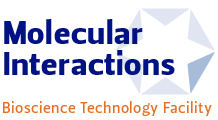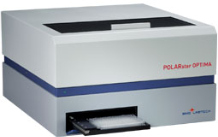Microplate reader
Facilities
UPDATE: We now have a BMG Labtech Clariostar Plate Reader installed.
This supersedes all the facilities of the Optima as detailed below,
with a monochromator system for fluorescence measurements, allowing
flexible selection of excitation and emission wavelengths and
bandwidths between 320 and 700 nm; and for absorbance measurements
a full spectrum 220 to 900 nm detector. Analysis software is much
easier to use and exports data directly to Excel. New users will
be trained on the Clariostar and existing Optima users moved over
at their convenience. (The Optima will be kept in use as long as
necessary).
BMG Labtech POLARstar OPTIMA, a microplate reader that incorporates five different measurement principles:
- Absorbance
- Fluorescence intensity
- Time-resolved fluorescence
- Fluorescence polarisation
- Luminescence
The light source is a high-energy xenon flash lamp and the detector is a side window, current-type photomultiplier tube. Light from the flash lamp passes through the excitation filter and down a light guide to the plate well, then transmitted/ emitted light comes back up a second light-guide and through the emission filter to the detector. Absorbance and fluorescence measurements use a common measurement head, with alternative, optimised heads for polarisation and luminescence.
There are two filter wheels (excitation and emission) each holding 8 filters:
| Excitation wheel | Range/nm | Emission wheel | Range/nm |
|---|---|---|---|
| Ex 355 | 332-371 | Em 460 | 450-475 |
| A 340 | 336-334 | Em 590 | 586-598 |
| 485-P | 477-491 | 520-P | 515-547 |
| Ex 584 | 570-585 | Em 612 | 610-616 |
| 640-10 | 635-646 | 680-12 | 674-684 |
| A 450 | 446-454 | Lens | - |
| 340-10 | ? | 520-P | 515-547 |
| A 620 | 617-622 | Empty | - |
The filter wheels are software controlled, allowing measurements at multiple wavelengths (eg different excitation/emission pairs for different fluorophores).
There are two additional excitation filters:
- Ex 544 (range 532-549 nm)
- A 492 (range 488-495 nm)
that can be fitted on request.
The plate reader can cover the wavelength range from 240 to 740 nm and we can obtain additional filters within this range to meet users' requirements.
All plate formats from 6-well to 384-well plates, can be read in all five measurement modes. Plates can be read from the top or the bottom. The control software will make multiple timed reads of a plate, allowing the progress of reactions, enzyme kinetic curves etc. to be measured.
The temperature can be regulated by a heating system in the plate movement area providing uniform incubation from 25°C to 45°C.
The plate reader is also equipped with two syringe pumps allowing up to two reagents to be injected into the sample. The delivery speed is adjustable from 100-420 ul/s. The injection volume is adjustable from 3-350 ul in 1 ul increments and is individually adjustable for each well. Mixing of added reagents with sample is achieved via a selection of shaking modes with user-definable time and amplitude. Allowance is made for up to 4 injection events per well. Measurements can be taken in plate mode (reagent added to all wells, then all wells read) or well mode (injection and read for each individual well before passing to the next).
Applications
The plate reader can be used for a wide range of non-radioactive labelled applications:
- Ca2+ measurements (eg Ca2+ flux with appropriate fluorophores)
- Molecular interactions
- Enzyme activity
- Cell toxicity, proliferation and viability
- ATP quantification
- Immunoassays
Many kit assays are already optimised for the 96-well plate format, but almost any colorimetric or fluorometric assay can be adapted for the plate reader. We are happy to provide advice on setting up non-standard methods.
Plates
All plate formats, from 6-well to 384-well plates, can be read in all five measurement modes.
- Absorbance measurements Standard transparent NUNC plates can be used for most samples.
- Fluorescence measurements Black plates eliminate crosstalk between wells and reduce back-scattered light.
- Luminescence measurements White plates give maximum reflection so may offer some advantage over transparent plates for weakly luminescent samples. For very strongly luminescent samples, black plates may be better.
We can provide small numbers of sterile, individually-wrapped, flat-bottomed, black or white 96-well FluoroNunc plates with lids (total volume 400ul); ordering information for larger volumes is available.
Plates can be read from the top or the bottom - for readings from the bottom the base must be transparent, whatever the colour of the sides of the wells.
Heads
Always check that the appropriate measurement head is installed for your intended application.
- Absorbance and fluorescence measurements use a common measurement head which has three light guides - two of the light guides are labelled with the letters A (absorbance) and F (fluorescence).
- Fluorescence polarisation measurements use a different three-pipe measurement head on which the light guides are much thinner than those on the absorbance/fluorescence head.
- For luminescence measurements use the single-pipe measurement head, colour coded blue.
The card inside the measurement head compartment describes how to connect the light guides correctly for each measurement mode.
The software measurement mode must be changed (click on the spanner icon) if the measurement head is changed.


